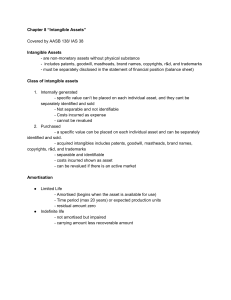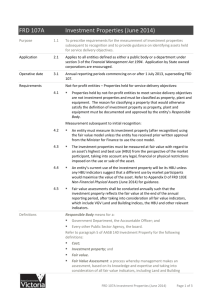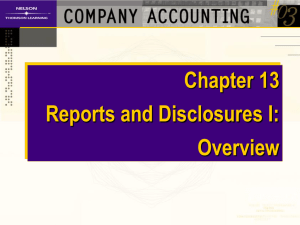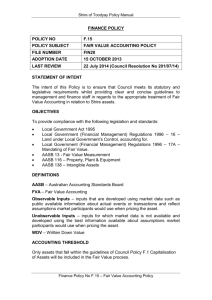ICAA Model Budget Taskforce, Daniel -Shea (LGV)
advertisement
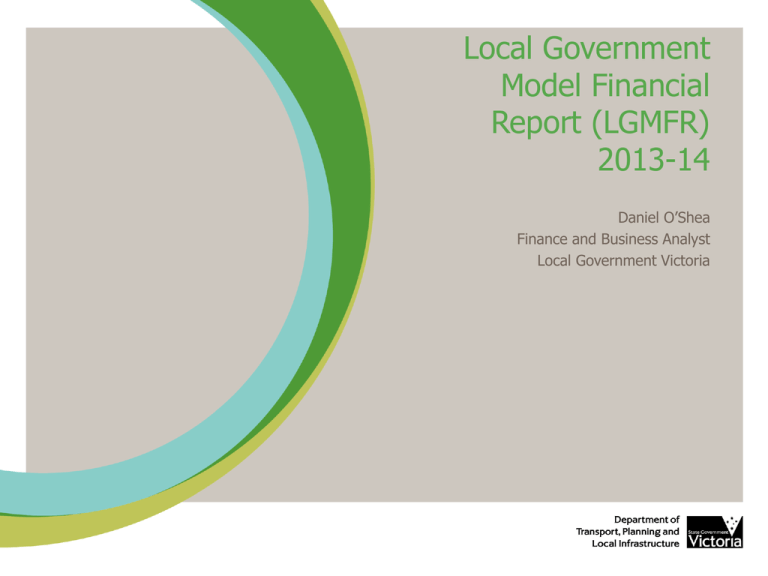
Local Government Model Financial Report (LGMFR) 2013-14 Daniel O’Shea Finance and Business Analyst Local Government Victoria Background Why prepare a Model Financial Report? Support councils in meeting their reporting obligations under the Local Government Act 1989 and compliance with the Australian Accounting Standards Provide guidance and promote consistency in financial reporting Encourage transparency and integrity in council financial statements and disclosures 2 Background Who’s involved? Collaboration between Local Government Victoria and key stakeholders Advisory working group formed with representatives from LGV, CPA Australia, FinPro and VAGO Crowe Horwath assist with updating the LG model financial report and provide technical advice Production assistance from CPA Australia 3 What’s changed for 2013-14? Accounting Standards AASB 13 Fair Value Measurement • Effective for reporting periods beginning on or after 1 January 2013 • Describes how to measure Fair Value when required / permitted by other accounting standards • Requires application of a Fair Value hierarchy • Contains additional disclosure requirements 4 What’s changed for 2013-14? Accounting Standards AASB 119 Employee Benefits • Effective for reporting periods beginning on or after 1 January 2013 • Changes the definition of short-term employee benefits • Now defined as employee benefits expected to be settled wholly before twelve months after the end of the reporting period in which the employees render the related service • Impact on accrued annual leave balances which are now classified as long-term benefits 5 What’s changed for 2013-14? Accounting Standards AASB 119 Employee Benefits (continued) • Resultant change of measurement for that portion of AL from nominal to Present Value (discounted) basis • Enhancements to support the note disclosure on Defined Benefit Superannuation have also been included • Includes added text on potential need for councils to provide additional funds (eg. calls) • Also increased disclosure of most recent actuarial assessment of the fund and number of council staff who are members 6 What’s changed for 2013-14? Transition to the new 2014-15 reporting regime Asset Classes • Property, Infrastructure, Plant and Equipment (Note 22) contains additional asset classes • Also reflected in updated asset classes under Capital Expenditure (Note 47) • Both changes signal more detailed and consistent disclosures on asset classes proposed under the 2014-15 reporting regime 7 What’s changed for 2013-14? Transition to the new 2014-15 reporting regime Statement of Capital Works • The proposed Local Government (Planning and Reporting) Regulations 2014 require the financial statements to contain a Statement of Capital Works • Statement of Capital Works will include more detailed asset classes • Due to transitional requirements a Statement of Capital Works has been included in this year’s Local Government Model Financial Report • This requirement will satisfy the reporting linkage between the budget and the LGMFR during transition 8 Availability When is it available and where do I find it? Available to access online next week • Currently subject to final quality assurance processes before publishing • Accessible on Local Government Victoria website and via link from CPA Australia website • URL: http://www.dpcd.vic.gov.au/localgovernment/publications-and-research/assetmanagement-and-financial 9 For more information Daniel O’Shea Finance and Business Analyst, Local Government Victoria daniel.o’shea@dtpli.vic.gov.au (03) 9208 3839 10
